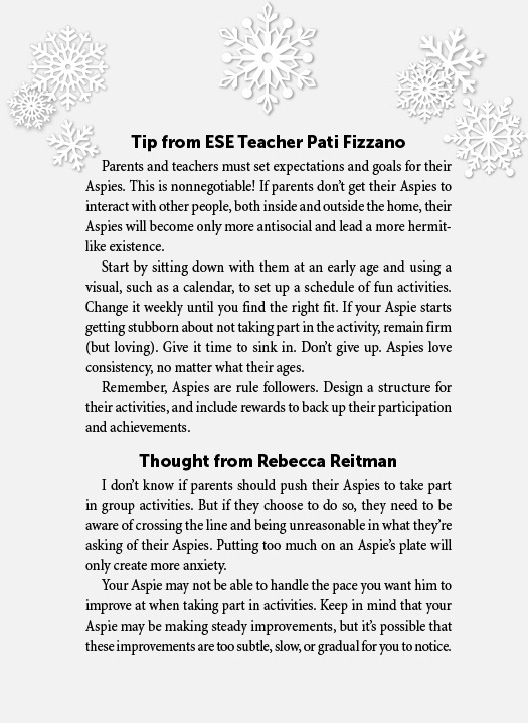
9 Structure and Positive Activities
The happiest people are
those who are too busy to notice
whether they are or not.
—William Feather
Helpful Hint: An Aspie’s daily schedule should be marked by structure. Sure, structure is vital for every person, for every type of brain—we all need a full dance card. But it’s that much more important for the Aspie. An Aspie who is in a routine that incorporates positive, productive activities is an Aspie who is doing well. Positive activities give Aspies feelings of self-worth and self-esteem, ward off depression, eliminate isolation, and enable them to socialize.
I
f things seem to be spiraling out of control for your Aspie, when it seems like there’s no clear-cut path for his long-term happiness, the magic bullet is structure.
Principle: For Aspies, structure means having a regular place to go and being involved in a productive activity that makes them want to get up in the morning, perform all the morning activities on their checklists, and be on time for the bus. Structure and activities serve to remind Aspies that life is not a one-way street and that there’s more to it than just thinking about oneself. It means having a purpose in life. It means being with other people and helping them. Helping others is a part of the ideal structure for an Aspie (as it is for all of us).
A few examples will help illustrate this principle. A friend’s son who is an Aspie had been floundering for years. Robbie struggled to finish high school, then started experimenting with marijuana. He ended up in a rehab program. His parents sent him to a series of therapists and other mental health professionals. They even put him in a wilderness program out West. Nothing seemed to work.
Then a friend of the family found Robbie an entry-level job at a hamburger restaurant. He’d get up each morning, shower, shave, put on his work uniform, and drive to his job, where he’d work long hours. It turned out Robbie loved all the structure and the routine activities the job entailed. He’d return home each evening, spend time talking with his folks, watch TV, go to sleep, then get up the next morning and start the routine again.
Now Robbie has straightened out the other aspects of his life: no more drugs, no more drama. On his days off, Robbie goes to movies with friends. At work he’s been promoted to assistant manager. He’s even thinking of buying his own franchise (with his family’s financial assistance). Robbie couldn’t be happier, and his folks couldn’t be more thrilled.
My daughter, Rebecca, wanted more independence and decided that she didn’t like living so close to her parents. She applied to live at a supervised independent living complex about a half-hour drive on the highway away from us.
ESE teacher Pati Fizzano became Rebecca’s mentor, coach, and teaching colleague. Rebecca started taking the bus for the disabled to the middle school where she would work alongside Pati each day from 3:30 to 5:45 tutoring, mentoring, and caring for the Aspies in the after-school program. Pati would then drive Rebecca to her house, where Rebecca tutored math in the Individualized Education Program (IEP) for private high school and college students with similar learning challenges, including Asperger’s. In these one-on-one sessions, which sometimes go for over three hours per student, Rebecca uses her gifts to reach, teach, and inspire students whose brains work a bit differently. After the sessions, Pati would drive Rebecca back to the independent living facility.
This makes for a long day—for both Pati and Rebecca—with the tutoring sessions often not over until 10:00 pm. But being busy with what she’s good at and loves to do gave Rebecca greater self-esteem. Her daily life now had structure, and the more structure there was, the more activities she added. It became a self-fulfilling circle. She got into the flow of life. Of course, the tutoring activities involved socialization as well. So for Rebecca, all the dots started to connect.

After Ralph couldn’t make college work out for him, he returned to his parents’ home to live. Ralph had tried to go away to college but couldn’t go through with it because his friend, who was also supposed to attend, cancelled at the last minute. So Ralph went to a local state school and lived at home. This proved to be a bad situation. Ralph was socially awkward, and he slept in every day. Because he was isolated and not doing anything constructive, he became somewhat depressed. His well-meaning parents watched helplessly as their son with Asperger’s stagnated.
Luckily, Ralph’s dad called in a favor and got his son a job at a friend’s pizzeria as a delivery man. It turned out to be his dream job. It provided just the right amount of socialization and taught Ralph about responsibility and earning money. And the hours suit him to a tee, because he still likes to sleep through until late morning. His parents can now focus on other adolescence- and Aspie-related battles.
ACTION PLAN: Structure and activities go hand in hand. You can’t allow your Aspie to become isolated, sitting alone in his room, whether at the computer, watching TV, or listening to music. Being alone in his room on a computer does not count as structure. He must interact with others, help others when possible, and fill up the days with worthwhile activities. Try to harness your Aspie’s interests into positive activities, such as a job, a hobby, a sport or recreational activity, volunteering at a nursing home or a youth center, or helping out at school. Structured activities are the foundation for a happy and fulfilling life for all of us, but especially for the unique individuals we call Aspies.

